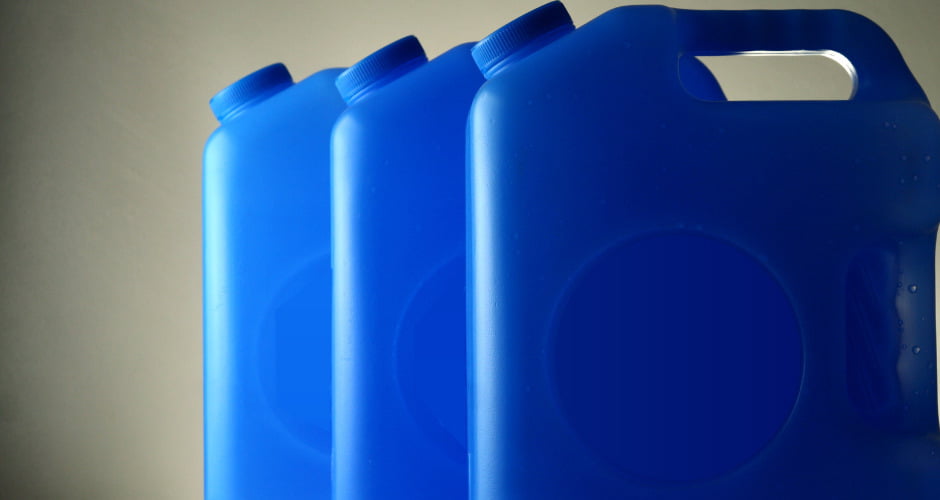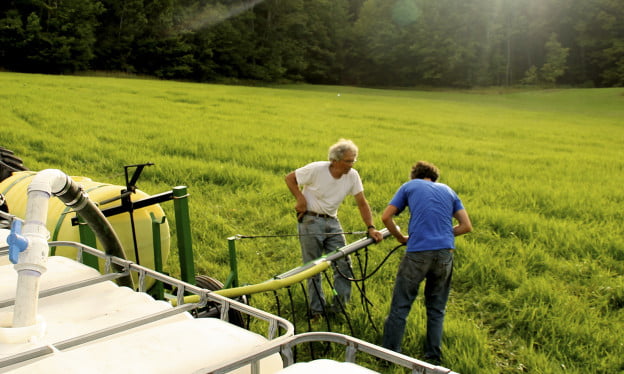Human urine is a fantastic free fertilizer for the garden. If you’re already having the “ick factor” response, we encourage you to keep an open mind and read on about using urine as a fertilizer.
Using urine in the garden makes sense not only from a sustainability standpoint but also from a scientific one. It’s rich in the very nutrients plants need—most notably nitrogen, phosphorus, and potassium (NPK). In fact, urine’s natural composition resembles the NPK ratios found in commercial fertilizers. Unlike synthetic fertilizers, though, it’s renewable and doesn’t require fossil fuels to produce.
Plus, using urine in the garden fits beautifully into regenerative and permaculture gardening practices. It’s a closed-loop system: you’re recycling nutrients that would otherwise enter wastewater treatment plants and instead putting them right back into the soil to grow more food.
Note: much of the information here comes from the work of the Rich Earth Institute. They’re conducting large-scale trials of urine collection and agricultural use. Check them out! You can download their handy Home Gardener Guide to Using Urine as a Fertilizer from Rich Earth Institute, which is a great reference.


Urine is rich in nitrogen and phosphorus, as well as lots of secondary and micronutrients that plants need for growth. It’s basically a well-balanced plant food that comes right out of your body every day, at no cost. Currently, wastewater treatment systems and infrastructure around this country and the world are under increased stress due to unpredictable weather and aging components. As a result, human waste can end up polluting rivers, lakes, and groundwater when these systems fail. So, when we use pee in our gardens, we’re not only giving our plants what they need for free, we’re also diverting from a waste stream.

Pee is proven plant food
Rich Earth’s field tests on hay crops over several years have shown equivalent yields between urine-fertilized and chemically-fertilized test plots; both significantly higher than unfertilized plots. Forage quality remained high, and one farmer has been able to achieve a solid second cutting of hay with urine as a fertilizer. Previously, yields were not sufficient to warrant harvesting again.
Composition of human urine
In comparison with feces, urine is actually a much higher quality fertilizer. This might seem surprising, since we’re so used to using manures of various kinds in the garden. In fact, human urine contains over 80% of the nitrogen and over 65% of the phosphorus that we flush away each day. In fact, pee has more of the good stuff plants need than poo does. Plus, urine doesn’t harbor pathogens and bacteria, like feces, and is relatively easy to sanitize, if need be.
Here’s a general breakdown of what you’ll find in fresh urine:
- Nitrogen (as urea): ~0.6% by volume
- Phosphorus (as P₂O₅): ~0.05%
- Potassium (as K₂O): ~0.15%
- Micronutrients: calcium, magnesium, sulfur, boron, zinc, and more
In gardening terms, this is roughly equivalent to a 10:1:4 NPK fertilizer. It’s especially beneficial for leafy greens and other nitrogen-loving plants.
Keeping things sanitary when using urine as a fertilizer
Urine can carry some viruses and bacteria, so if you’re using it on vegetables you’ll be sharing with folks outside of your household, the World Health Organization recommends that you sanitize it. This just means either leaving it in a closed container for 6 months or more before using, or pasteurizing by heating it to between 160-180℉ for 30 minutes. If you’re just using urine from your own household, for vegetables that will be eaten by members of that household, sanitization isn’t necessary. Both of the lead instructors in our gardening classes have been using pee on their gardens for years and have never run into any issues.
How to pasteurize urine for fertilizer
If you plan to share produce with others or use community-collected urine, sanitizing it is a good idea. Pasteurization is a simple method:
- Collect urine in a clean container.
- Heat it to 160–180°F (70–82°C).
- Keep it at that temperature for 30 minutes.
You can do this on a stovetop, in a solar oven, or even in a slow cooker with a thermometer. After pasteurizing, store the urine in a sealed container until you’re ready to use it in the garden.


Challenges of using urine as a fertilizer — and how to overcome them
Smell
We’re not going to lie, a jug of pee is going to be a bit stinky. Adding white vinegar to your collection vessel can help dramatically. Rich Earth recommends about 4 cups of vinegar for a 5 gallon jug of pee; you can make adjustments to this ratio based on your collection vessel.
Collecting urine
Choosing the right collection vessel is important, too. Being a liquid fertilizer, urine is heavy, and it sloshes around on the way to the garden. You may want to use a 5-gallon bucket, since they’re so easy to find and easy for anyone to pee into. In this case, be sure to source a tight-fitting lid for transport, and don’t fill it up to the tippy-top before carrying it outside. Five gallons of liquid can be quite heavy, so a smaller vessel might be more appropriate for you. We like unused fuel canisters, with a large funnel inserted for easy use by any gender. You can usually get 3-5 gallon plastic jugs with screw tops from restaurants for free; they receive cooking oil in these vessels.
Salts
A lot of folks worry about salts accumulating in areas fertilized with urine. In Rich Earth’s trials, they haven’t found this to be an issue. However, they suggest extra caution and monitoring in greenhouses, container gardens, and very dry places. If salts do build up (as evidenced by a soil test), you can flush them out with fresh water. Similarly, Rich Earth hasn’t recorded significant pH changes, but they suggest regular soil testing (every few years, which is a good idea anyway) to monitor this in your particular conditions.
The “ick” factor
And finally, the “ick factor” can get in the way for many gardeners who otherwise would love a free and effective fertilizer source. Our suggestion here is to think about where your other fertilizers come from. Chemical fertilizers are mostly made from fossil fuels, and their manufacture produces climate-warming gasses; manure is poop; fish emulsion is liquified decomposing fish bodies. The bottom line: death and decay and metabolic waste products are what fuel life on this planet. Embracing the beauty of these cycles can turn the “ick factor” into an “awe factor.”
How to use urine as a fertilizer in the garden


Image credit: Rich Earth Institute.
Adults produce between 100 and 150 gallons of urine per year, containing about 9 pounds of nitrogen and 0.8 pounds of phosphorus. Used to fertilize grain, this is enough to grow wheat for making a loaf of bread every day of the year. So, depending on the size of your garden, you may not need to import any other nitrogen and phosphorus sources. Keep in mind, however, that urine does not replace the important roles of compost, organic matter, and mineral-rich amendments like kelp, when they’re needed.
As with any nitrogen-containing fertilizer, you don’t want to overdo it and pollute groundwater. Nitrogen is very water soluble, and any amount that isn’t taken up by green, growing plants will wash away. Only use pee on plants that are green and growing (not germinating seeds, tiny seedlings, or plants that have moved into their fruiting stage).
The best way to apply urine is as a soil drench, directly to moist soil. If your soil is dry, you can dilute the urine with water (we usually use a 1:1 ratio), or irrigate immediately after application. Never spray urine directly on the leaves or stems of plants, but rather pour it into the soil about 4” away from the base of the plant.
How to mix urine for fertilizer
Urine can be used full-strength or diluted, depending on your garden’s moisture level and the types of plants you’re feeding. Here are some general guidelines:
- 1:1 dilution (urine:water): Ideal for vegetables and flowers during active growth.
- 1:10 dilution: For more sensitive plants, seedlings, or dry soils.
- Full strength: Only if applying directly to well-watered soil.
Always apply as a soil drench, never foliar feed with urine. And avoid applying to plants that are flowering or fruiting.
How often to use urine fertilizer for plants
Urine can be applied every 7–14 days during the active growing season. For heavy feeders like corn or brassicas, you may want to fertilize weekly. For lighter feeders or herbs, every 2–3 weeks is plenty. Be sure to alternate with compost or organic mulch to support soil health.
Is Female Urine Good for Plants?
Yes! Female urine is just as good for plants as male urine. There is no significant difference in nutrient content between male and female urine under normal health conditions. Factors like hydration levels, diet, and medications affect urine composition more than gender does.
Concerns about hormonal content in female urine (such as estrogen) are not supported by research as a limiting factor in garden use. In fact, two of the instructors of our gardening classes—who are female—have been using their own urine in their gardens for years with healthy, productive results.
Which Plants Benefit Most from Urine Fertilizer?
Urine fertilizer is especially beneficial for plants that require high levels of nitrogen. Leafy greens like lettuce, spinach, kale, chard, and arugula thrive with regular applications. So do brassicas like broccoli, cabbage, and cauliflower. Corn is another heavy nitrogen feeder that responds very well to diluted urine.
On the other hand, some plants prefer less nitrogen or can fix their own. Peas and beans, which are legumes, already have nitrogen-fixing bacteria in their root systems and don’t need much added. Root vegetables like carrots and beets may become overly leafy if they receive too much nitrogen.
Use caution with flowering or fruiting plants like tomatoes and peppers—too much nitrogen can delay blooms and fruit set. In these cases, apply urine early in the season when vegetative growth is key, and taper off as the plant matures.
When Not to Use Urine in the Garden
Although urine is a powerful and free fertilizer, it’s not appropriate in every situation. Avoid using it:
- On very young seedlings or newly germinated seeds
- During dry spells when water isn’t available for dilution or post-application irrigation
- In poorly draining soils, where nutrient buildup could harm plants or leach into groundwater
- On crops that are eaten raw and grow close to the soil, like lettuce or radishes—unless the urine is sanitized
Also be cautious in greenhouses or containers where salts can build up more quickly. A soil test can help identify early signs of nutrient imbalance or excess salt.
Cultural Perspectives on Urine Use
While using urine in the garden may seem taboo in some cultures, it’s a long-standing and respected practice in many others. In traditional Chinese agriculture, “night soil” systems included urine and human waste as a vital part of crop fertility. Scandinavian countries like Sweden and Finland have researched ecological sanitation extensively, including urine diversion toilets and home-scale fertilizer systems.
Modern organizations like the Rich Earth Institute are helping to shift the narrative in the United States by conducting scientific research and public education on the benefits of urine recycling. Their work demonstrates that what was once seen as waste can become a safe, effective, and sustainable agricultural resource.
Learning more about the cultural and ecological value of urine can help shift the mindset from “ick” to inspiration—and empower more gardeners to give this age-old practice a try.
Frequently Asked Questions About Using Urine as a Fertilizer
Urine can be used as a fertilizer because it is a highly effective and free source of nitrogen, phosphorus, and potassium—key nutrients for plant growth. It’s been used for centuries in traditional agriculture and, when applied correctly, can match the effectiveness of commercial fertilizers.
On average, human urine contains about 0.6% nitrogen by volume. This means a typical adult produces enough nitrogen in their annual urine output to fertilize a small garden for the entire growing season.
Dilute fresh urine with water before applying it to plants. A common ratio is 1:1 (urine to water) for well-established plants, and 1:10 for seedlings or sensitive crops. Always apply to the soil—not leaves—and avoid overuse.
Apply diluted urine fertilizer every 1–2 weeks during the growing season, especially for nitrogen-hungry plants like leafy greens and corn. Reduce frequency during hot or dry conditions, and always water afterward if soil is dry.
Fresh urine doesn’t smell strongly, but when stored, it can become odorous. To minimize smell, add white vinegar to collection containers (about 4 cups per 5 gallons) and use sealed lids for transport.
If you’re applying urine to food crops that others will consume, it’s best to sanitize it. Pasteurize by heating to 160–180°F for 30 minutes, or store sealed for 6 months. For home use on personal gardens, fresh urine from healthy individuals is typically safe to use immediately.
Ready to Put This Knowledge to Use?
Using urine as a fertilizer is one of the most accessible and effective ways to boost garden health while supporting a regenerative, closed-loop system. Whether you’re gardening in containers, raised beds, or a backyard homestead, applying this ancient method with modern care can help your plants thrive.
Want to learn more techniques for growing food sustainably? Join our one of gardening classes and deepen your understanding of soil health, composting, companion planting, and much more. Our expert instructors share practical, time-tested knowledge you can start using right away.

